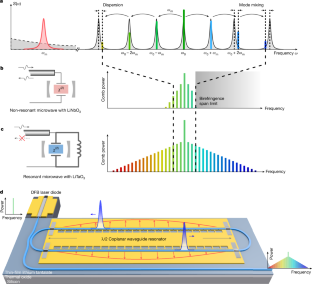Here is a significant breakthrough in frequency comb technology using lithium tantalate, representing a major advance in the field of optics. Frequency combs, which enable extremely precise light measurements, have been crucial tools in telecommunications, environmental monitoring, and astrophysics, but their complexity and practical limitations have historically restricted their widespread adoption.
The development of frequency combs traces back to 1993 with electro-optic frequency combs using cascaded phase modulation. However, these early versions faced challenges with high power requirements and limited bandwidth. This led researchers to explore alternative approaches like femtosecond lasers and Kerr soliton microcombs, which, while effective, introduced their own complications through complex tuning processes and substantial power demands.
The breakthrough came through a collaborative effort between scientists at EPFL, the Colorado School of Mines, and the China Academy of Science, led by Professor Tobias J. Kippenberg. Their innovation centers on using lithium tantalate instead of the traditional lithium niobate. The key advantage of lithium tantalate is its significantly lower intrinsic birefringence—17 times lower than lithium niobate—which helps prevent light beam splitting that previously limited bandwidth capabilities.
The team developed an electro-optic frequency comb generator with remarkable specifications: it achieves 450 nm spectral coverage and generates over 2,000 comb lines. Perhaps most importantly, it reduces microwave power requirements by almost 20 times compared to previous designs. This was accomplished through an “integrated triply resonant” architecture where two optical fields and one microwave field resonate together harmoniously.
The device’s design is notably compact, fitting within a 1×1 cm² area. It operates using a simple, free-running distributed feedback laser diode, making it considerably more user-friendly than Kerr soliton-based alternatives. The system maintains stable operation across 90% of the free spectral range and doesn’t require complex tuning mechanisms, marking a significant improvement over existing technologies.
To achieve these improvements, the researchers integrated monolithic microwave circuits with photonic components and embedded a distributed coplanar waveguide resonator on lithium tantalate photonics integrated circuits. This co-designed system significantly enhanced microwave confinement and energy efficiency.
The implications of this breakthrough extend beyond just technical specifications. The combination of the device’s robust design, compact size, and improved efficiency opens up new possibilities across various fields. In robotics, it could enhance laser ranging capabilities for more precise measurements. In environmental monitoring, it could enable more accurate gas sensing. The success of this co-design methodology, combining microwave and photonic engineering, suggests promising directions for future device development.
Moreover, this advancement addresses several long-standing challenges in the field of frequency combs. The reduced power requirements and elimination of complex tuning processes make the technology more accessible and practical for widespread implementation. The achievement of ultra-broadband span coverage while maintaining stable operation represents a significant step forward in making this technology more reliable and user-friendly.
The breakthrough demonstrates how innovative material choices and integrated design approaches can overcome seemingly fundamental limitations in optical technology. By successfully combining advances in materials science, microwave engineering, and photonics, the research team has created a device that could significantly impact the future of optical technology and its applications across multiple industries.
Reference: “Ultrabroadband integrated electro-optic frequency comb in lithium tantalate” by Junyin Zhang, Chengli Wang, Connor Denney, Johann Riemensberger, Grigory Lihachev, Jianqi Hu, Wil Kao, Terence Blésin, Nikolai Kuznetsov, Zihan Li, Mikhail Churaev, Xin Ou, Gabriel Santamaria-Botello and Tobias J. Kippenberg, 22 January 2025, Nature.
DOI: 10.1038/s41586-024-08354-4


